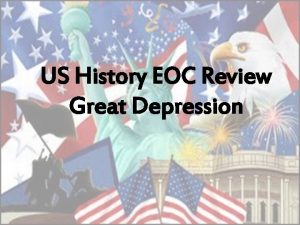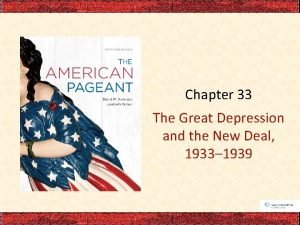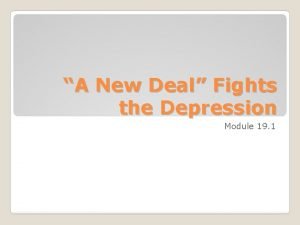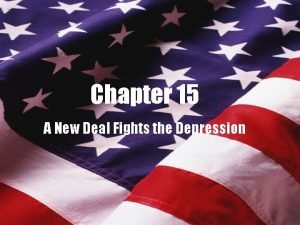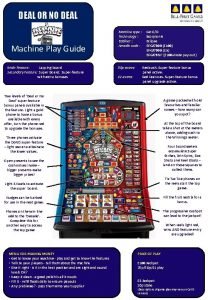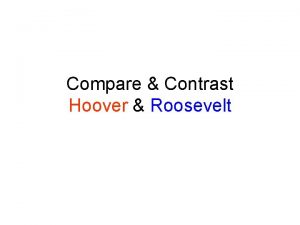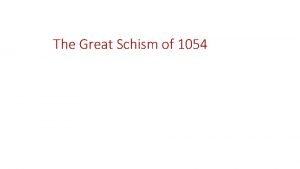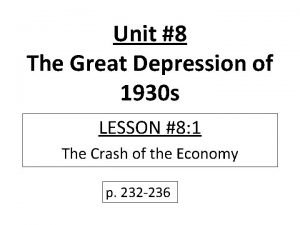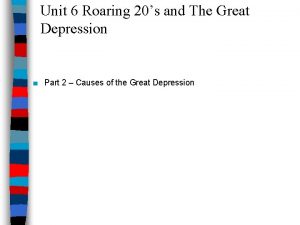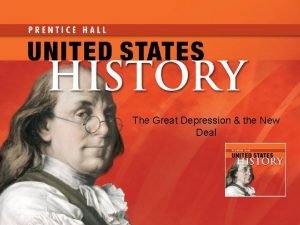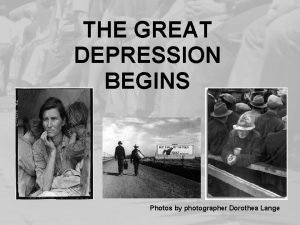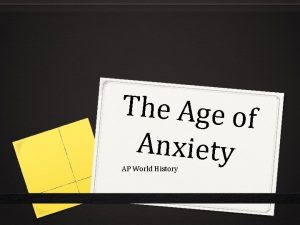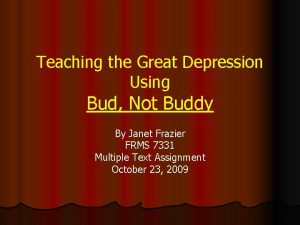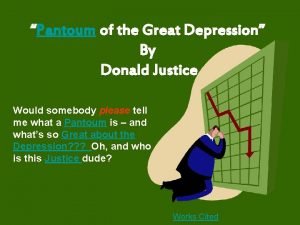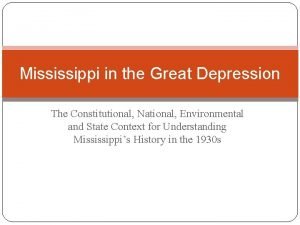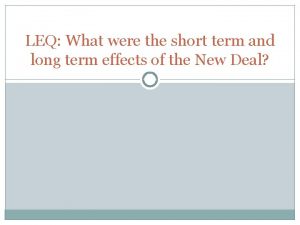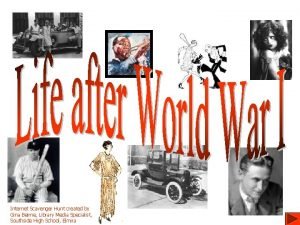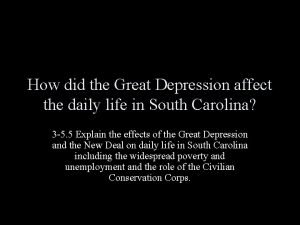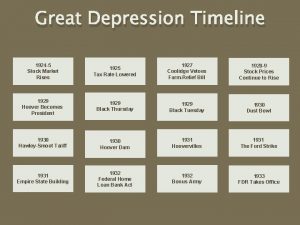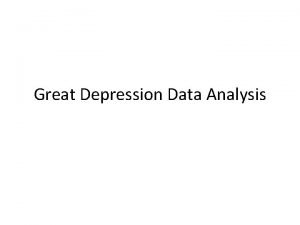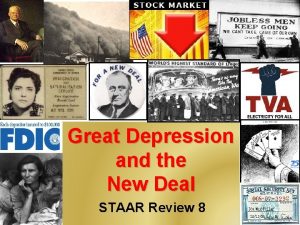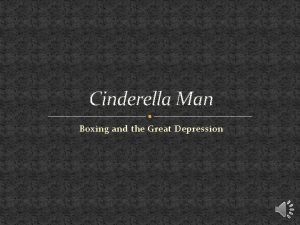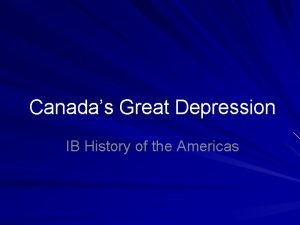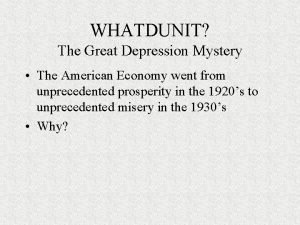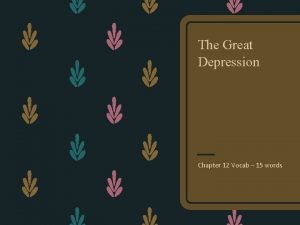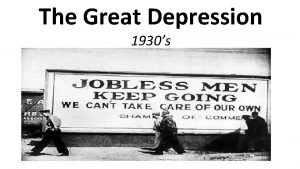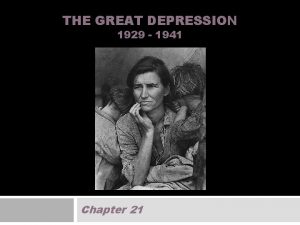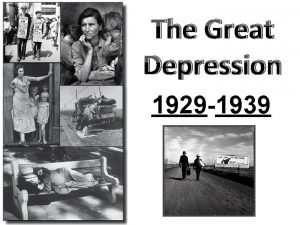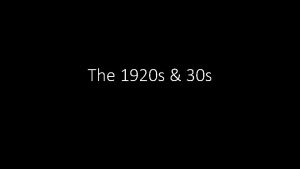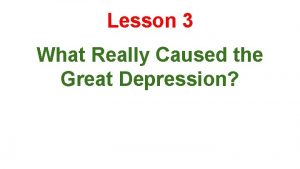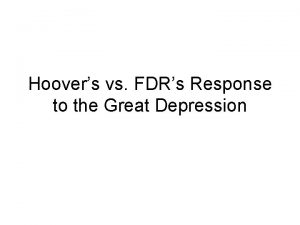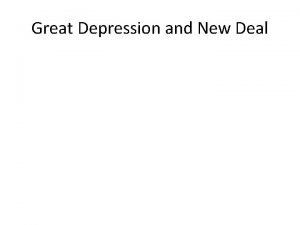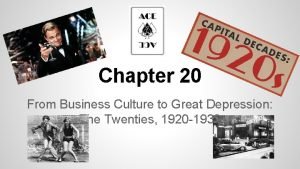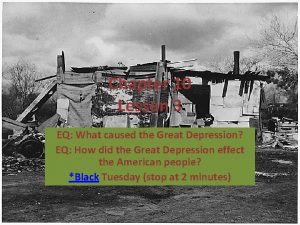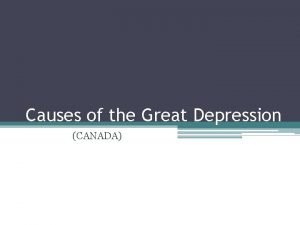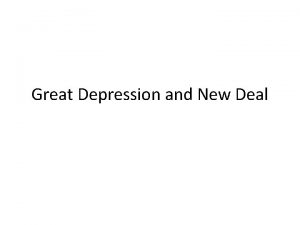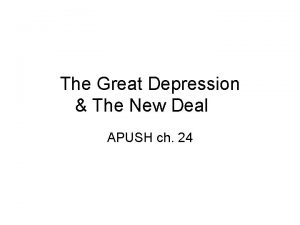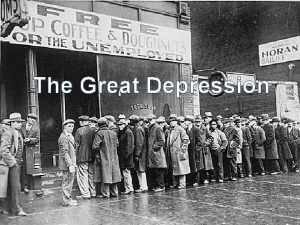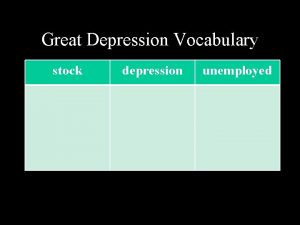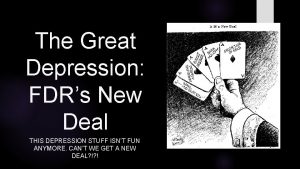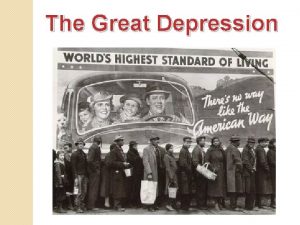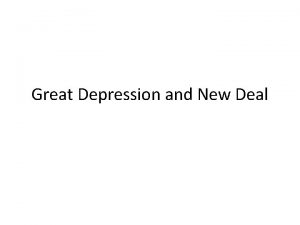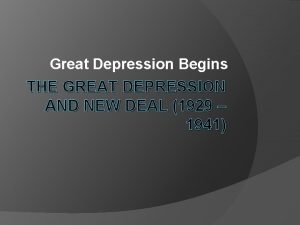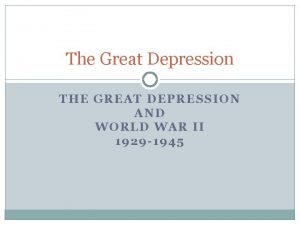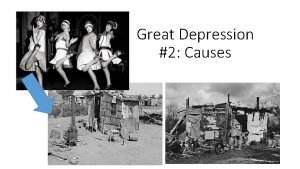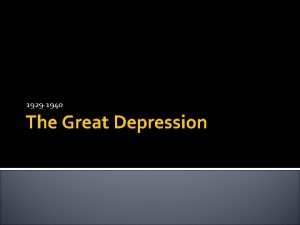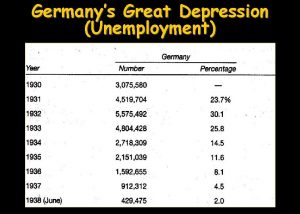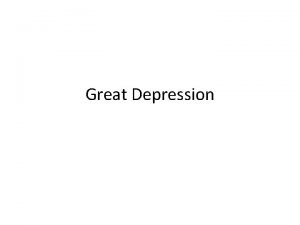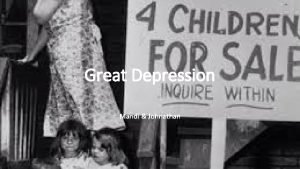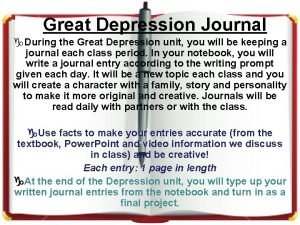The Great Depression and the New Deal APUSH





















































- Slides: 53

The Great Depression and the New Deal APUSH - Unit 7 B R. M. Tolles

Warning Signs n Causes of the Great Depression n Industries in Trouble – Railroads, Textiles, Steel, Coal, and Building Houses. n Farmers Struggling – Not Making the same amount they were during WWI. Price Supports. n Living on Credit. – Borrow Money, Pay it off later. n Uneven Distribution of Income – Poor people couldn’t buy things. n Additional Causes – unequal distribution of income, imbalance in foreign trade, and easy credit*

ELECTION OF 1928 n n Alfred E. Smith – Democrat. Great People Person. Herbert Hoover – Republican. Sec. of Commerce under Harding and Coolidge during Roaring 20’s. “We in America are nearer to the final triumph over poverty than ever before. ”

The Stock Market n Dow Jones Industrial Average – Measured the market’s “health” – reached a high of 381… 300 points higher than 5 yrs. before n Bull Market – A rising market n 4 million Americans were involved in the stock market n Speculation – High risk sharing. Going for the get-rich-quick, knockout punch, trade. n Buying on Margin – Paying 10% of a share, borrowing 90%, and paying off the 90% when the share makes money.

The Stock Market Crashes n n October 24, 1929 – The Stock Market blips. Black Tuesday – October 29, 1929 16. 4 Million Shares were dumped, millions left without buyers. By the end of the 1930 s, farmers, workers, veterans of WWI, and African American workers would all share in hard times, with rising unemployment and poverty. *

Domino Effect n Banks Closed – Banks lost everything they had invested due to buying on Margin. Closed. People lost life savings. 11, 000 banks closed (almost half) by 1933 n Businesses Closed – Businesses can’t function without banks, 90, 000 closed. n One out of Every four people were fired. n Those who kept their jobs got pay cuts and reduced hours. n The Great Depression had begun. n Effects fo the Great Depression



The Depression's impact on people: Consumer spending (in billions) on selected items, 1929 -33 1929 1933 Food $19. 5 $11. 5 Housing $11. 5 $ 7. 5 Clothing $11. 2 $ 5. 4 Automobiles $ 2. 6 $ 0. 8 Medical care $ 2. 9 $ 1. 9 Philanthropy $ 1. 2 $ 0. 8 Value of shares on the NYSE $89. 0 $19. 0 Historical Statistics of the United States, p. 319.


The Crash Heard ‘Round the World n n No more money sent to Germany, who then couldn’t pay England France, putting them in a Depression as well. Hawley-Smoot Tariff Act – designed to protect American farmers from foreign competition. Other countries did the same. Now U. S. can’t export.

Depression Life – Experience n Shantytowns – Towns of shacks that sprang up due to massive number of homeless. n Soup Kitchens and Bread Lines – Food provided for free by charitable organizations. n African-Americans were discriminated against. First to be fired, lower pay, and attacked by unemployed whites. n Latinos – also attacked by unemployed whites. Over hundreds of thousands were back to Mexico. Willingly and Deported.


Farmers n Rural life – Farmers could grow food for their families but 400, 000 farms were lost through foreclosure. n Dust Bowl – for 7 years, drought and wind in the center of the country. No way to grow food. everything covered in dirt. n 100’s of 1000’s moved to Pacific Coast. Route 66. Okies. n In the 30 s some farmers destroyed their crops instead of taking them to market to protest low prices for agricultural products. *


Depression Life (cont. ) n n n Monopoly is created in 1933 Men felt they needed to support their family. When they couldn’t, they ran away. Suicide Rates tripled. 300, 000 “hoboes” wandered the country. Women were too embarrassed to beg, and many died in their houses from starvation.


Herbert Hoover n Herbert Hoover was the President n He declined Direct Relief - which is the Government giving people money to get them back on their feet. He favored federal assistance to business. * n Thought the economy would naturally recover. n Asked employers not to cut wages, or lay off workers. n Asked Labor leaders not to demand more pay. n Created private charities to provided for the poor.

Hoover Starts to Get Serious n Federal Home Loan Bank Act – Lowered Mortgage Rates for Homeowners. n Reconstruction Finance Corporation – Gave $2 Billion to get the banks, railroad, and life insurance companies up and running again. n Boulder Dam - Hoover ordered a Dam to be built on the Colorado River. n $700 Million project. Put many people to work. n Renamed the Hoover Dam. n Hoovers reluctance to use the federal government to provide direct relief during the Depression would cause harsh critics and his down fall. *

The Class must get 3 out of 4 to get a point… 1. Which two of Harding’s cabinet members worked hard to achieve advancements specifically for businesses? A Andrew Mellon and Albert Fall B Andrew Mellon and Herbert Hoover C Charles Forbes and Harry Daugherty D Herbert Hoover and Charles Forbes 2. What event occurred on Black Tuesday? A Unemployment reached nearly 25 percent. B The Federal Reserve lowered interest rates. C Investors sold more than 16 million shares of stock. D Germany stopped reparation payments to the United States. 3. What economic condition did economist John Maynard Keynes believe caused the Great Depression? A lack of government intervention B strict controls on stock speculation C too much oversight of the banking system D limits on production and consumer spending 4. Farmers contributed to the problems that led to the Dust Bowl by A putting down new layers of topsoil. B moving off of the plains to find new farmland. C damming western rivers and using irrigation techniques. D using intensive farming practices that removed protective grasses.

The Class must get 3 out of 4 to get a point… 1. Which two of Harding’s cabinet members worked hard to achieve advancements specifically for businesses? A Andrew Mellon and Albert Fall B Andrew Mellon and Herbert Hoover C Charles Forbes and Harry Daugherty D Herbert Hoover and Charles Forbes 2. What event occurred on Black Tuesday? A Unemployment reached nearly 25 percent. B The Federal Reserve lowered interest rates. C Investors sold more than 16 million shares of stock. D Germany stopped reparation payments to the United States. 3. What economic condition did economist John Maynard Keynes believe caused the Great Depression? A lack of government intervention B strict controls on stock speculation C too much oversight of the banking system D limits on production and consumer spending 4. Farmers contributed to the problems that led to the Dust Bowl by A putting down new layers of topsoil. B moving off of the plains to find new farmland. C damming western rivers and using irrigation techniques. D using intensive farming practices that removed protective grasses.


People turn against Hoover n n 1930 elections for congress went mainly to Democrats. People start calling Shantytowns Hoovervilles, newspapers Hooverblankets, and empty pockets Hooverflags


The Grapes of Wrath n In the novel, John Steinbeck writes, “in the eyes of the hungry these is a growing wrath. In the souls of the people the grapes of wrath are filling and growing heavy, growing heavy for the vintage, ” which is directed toward society being endangered by the Great Depression and the Governments refusal or inability to help. *

IT GOES FROM BAD TO WORSE – The Bonus Army n 1932 - WWI Veterans were promised a Bonus they could collect in 1945. But they wanted it now. Over 100, 000 of them Marched to Washington D. C. n They call themselves the Bonus Army n Sen. Wright Patman was on the side of the veterans. He introduced the Patman Bill but it got voted down. n Most of the Bonus Army left, but 2, 000 stayed.



REACTION n Hoover commanded Douglas Mac. Arthur and Dwight D. Eisenhower to disband the group. n Mac. Arthur showed up with 1, 000 soldiers and tear gassed over 1, 000 people, including a 8 month old baby who died, shot two people, and bayoneted many others. n The Bonus Army happened in an Election Year, and many people hated Hoover for it. n With the Country in shambles, a new leader will have to take upon one of the worlds largest financial crises.


The Class must get 3 out of 4 to get a point… 1. Why did the Bonus Army march on Washington, D. C. ? A The Federal Reserve refused to pay veterans their bonuses. B General Mac. Arthur attacked protestors demanding their bonuses. C President Hoover vetoed a bill providing for early payment of bonuses. D Congress passed a bill promising to pay veterans their bonuses in 1945. 3. President Hoover responded cautiously to the Great Depression because he A thought that the business cycle would correct itself. B was distracted by the giant dust storms in the Great Plains. C did not have any experience with business methods and economic theory. D believed that the federal government needed to take an active approach to recovery. 2. President Hoover urged Congress to institute the RFC because he believed that the economy suffered from A a lack of credit. B over-employment. C too much government regulation. D a concentration of wealth in large businesses. 4. Which of these factors contributed to the plight of rural farmers? A a long rainy season B decreased debt burden C falling prices for crops and livestock D increased demand for agricultural products

The Class must get 3 out of 4 to get a point… 1. Why did the Bonus Army march on Washington, D. C. ? A The Federal Reserve refused to pay veterans their bonuses. B General Mac. Arthur attacked protestors demanding their bonuses. C President Hoover vetoed a bill providing for early payment of bonuses. D Congress passed a bill promising to pay veterans their bonuses in 1945. 3. President Hoover responded cautiously to the Great Depression because he A thought that the business cycle would correct itself. B was distracted by the giant dust storms in the Great Plains. C did not have any experience with business methods and economic theory. D believed that the federal government needed to take an active approach to recovery. 2. President Hoover urged Congress to institute the RFC because he believed that the economy suffered from A a lack of credit. B over-employment. C too much government regulation. D a concentration of wealth in large businesses. 4. Which of these factors contributed to the plight of rural farmers? A a long rainy season B decreased debt burden C falling prices for crops and livestock D increased demand for agricultural products


Franklin Delano Roosevelt n Elected President in 1932 Election n Ran Against President Hoover n Was A Reform-Minded Governor n Favored direct federal relief programs instead of federal assistance to businesses. n Eleanor Roosevelt would change the role of 1 st Lady by championing the cause of ordinary people. n FDR passed a group policies in the first onehundred days of taking office. Launched in 1933 n In his Fire Side Chats – FDR explained the new deal. He ended the Gold Standard, declared bank holidays to stop the panic, this halted bank failures and begun the restructuring process.

New Deal n Immediately established his “brain Trust” of advisors n Set out to end the great Depression with his “New Deal” plan. n Focused on relief for the needy, economic recovery, and financial reform. n Fireside chats n Tried Court Packing – but failed (illegal) n Appointed the 1 st female Sec. Of Labor – Francis Perkins n FDR’s plan was based on John Maynard Keynes – spend heavily to jump start the economy, Many opposed due to the debt it would create.


The First Hundred Days n Glass-Stegall Act – This insured the money in Banks, so people wouldn’t lose it. n Federal Securities Act – Made companies be liable for their stock information. Federal Deposit Insurance Corporation (FDIC) – regulation and insurance of banks. n Securities and Exchange Commission (SEC) – regulate the stock market n Home Owner’s Loan Corporation – finance new homes. n Social Security Act would have the greatest impact on the average citizen for years to come.


Agriculture and Industry Agricultural Adjustment Act (AAA) – Raise crop prices by lowering production. Gov’t would pay farmers for unused land. Farm Credit Administration for refinancing farm mortgages Civilian Conservation Corps (CCC) – Put young men to work. Keep men off streets. National Labor Relations Act – (NLRA)gave workers the right to organize unions and bargain collectively Tennessee Valley Authority (TVA) – financed rural electrification and helped develop the economy of a seven state area.

The New Deal is Under Attack n FDR in general was supported by a majority of Americans, but his most outspoken critics were the Social Darwinists. n Many people thought FDR was putting the U. S. into bigger trouble because we were spending more money than we were making. n This was called Deficit Spending, or spending more money than the country makes. n Huey Long – Against the New Deal. Wanted a communist style gov’t. Was assassinated by a lone gunman. n Many felt the government had too much control over business interests.


Second Hundred Days n Eleanor Roosevelt – First Lady, did much charity work and helped keep FDR focused on the problem at hand. n Works Progress Administration (WPA) – Gave billions to create jobs immediately building libraries, schools, federal art projects, fixing roads, and sewing groups for women. n National Industrial Recovery Act (NIRA) Gave Money to states to build schools and other community buildings n Civilian Conservation Corps (CCC) – created forestry jobs for young men n Federal Emergency Relief Administration – funded city and state relief programs


The Class must get 3 out of 4 to get a point… 1. Some Americans blamed the Great Depression on A fascism. B capitalism. C socialism. D communism. 2. What were the goals of the New Deal? A reform the government and decrease spending B create schools and protect farmers C increase spending on defense and trade D provide relief, recovery, and reform 3. What did President Roosevelt introduce to help retirees? A Fair Labor Standards Act B Second New Deal C Works Progress Administration D Social Security Act 4. Roosevelt created the Securities Exchange Commission (SEC) to A regulate the stock market. B give banks a chance to organize. C ensure bank deposits. D pay farmers to destroy their livestock.

The Class must get 3 out of 4 to get a point… 1. Some Americans blamed the Great Depression on A fascism. B capitalism. C socialism. D communism. 2. What were the goals of the New Deal? A reform the government and decrease spending B create schools and protect farmers C increase spending on defense and trade D provide relief, recovery, and reform 3. What did President Roosevelt introduce to help retirees? A Fair Labor Standards Act B Second New Deal C Works Progress Administration D Social Security Act 4. Roosevelt created the Securities Exchange Commission (SEC) to A regulate the stock market. B give banks a chance to organize. C ensure bank deposits. D pay farmers to destroy their livestock.

Second Hundred Days (cont. ) n n n National Youth Program (NYA) – gave kids jobs, education, and recreation. Keep the kids off the streets. Wagner Act – Reestablished NIRA stronger Social Security Act – Acted as welfare for needy families and for retired people.


Greater Equality n During the Depression, African Americans had the most difficulty of any other group. n Frances Perkins – First female cabinet member (secretary of labor) n Mary Mc. Leod Bethune – Hired by FDR to head the Division of Negro Affairs of the National Youth Council. “Black Cabinet” n John Collier – Head of Indian Affairs. Indian Reorganization act of 1934. n New Deal Coalition – Minority support for Democrats


Unions Get Stronger n n Congress of Industrial Organizations (CIO) A few men in the AFL organized industry wide organizations. Were kicked out of the AFL but formed the CIO instead. Union protests went up over loss of wages that could not sustain workers families.

Culture in the New Deal Era n n n Gone with the Wind – Movie; shows a more glorious side to life during 1930’s Orson Wells – Radio, “The War of the Worlds” Grant Wood – Painter, American Gothic Richard Wright – Writer, Native Son John Steinbeck – Writer, Grapes of Wrath Golden Age of Hollywood

Depression is Coming to an End n n Federal Deposit Insurance Corporation (FDIC) – Guaranteed the money you put in a bank. Securities and Exchange Committee (SEC) Regulates trade and the stock market

Depression is Coming to and End (Continued) n n National Labor Relations Board (NLRB) Helped manage worker and employee relations to keep strike from happening Tennessee Valley Authority (TVA) – Created a Dam in Tenn. that gave people jobs and then also created electricity.
 Depression/new deal unit vocab
Depression/new deal unit vocab Main idea
Main idea Chapter 33 the great depression and the new deal
Chapter 33 the great depression and the new deal A new deal fights the depression
A new deal fights the depression Chapter 15 section 1 a new deal fights the depression
Chapter 15 section 1 a new deal fights the depression First new deal apush
First new deal apush A great deal vs a great many
A great deal vs a great many Deal or no deal machine
Deal or no deal machine Rudolf vizental
Rudolf vizental Compare and contrast hoover and fdr
Compare and contrast hoover and fdr The great depression lesson 2 hardship and suffering
The great depression lesson 2 hardship and suffering Pros and cons of the great depression
Pros and cons of the great depression New deal political cartoons and explanations
New deal political cartoons and explanations 1,000 species of finch have been identified.
1,000 species of finch have been identified. What was the deal breaker in the great schism
What was the deal breaker in the great schism Rarig great depression
Rarig great depression Great depression
Great depression The ingenious quarterback analysis
The ingenious quarterback analysis Foreclosure great depression
Foreclosure great depression Five effects of the great depression
Five effects of the great depression Five effects of the great depression
Five effects of the great depression How did the great depression impact the world
How did the great depression impact the world Great depression ap world history definition
Great depression ap world history definition Bud not buddy
Bud not buddy Donald justice pantoum of the great depression
Donald justice pantoum of the great depression The great depression summary
The great depression summary What is deflation
What is deflation Okies great depression
Okies great depression The great depression leq
The great depression leq Five effects of the great depression
Five effects of the great depression How did the great depression affect south carolina
How did the great depression affect south carolina Timeline of the great depression
Timeline of the great depression Great depression causes
Great depression causes Mexican repatriation apush
Mexican repatriation apush Hoovervilles
Hoovervilles Birth rate during the great depression
Birth rate during the great depression Overspeculation great depression
Overspeculation great depression Great depression vocab
Great depression vocab Great depression vocabulary words
Great depression vocabulary words Great depression
Great depression Http://www.history.com/topics/great-depression
Http://www.history.com/topics/great-depression Great depression
Great depression Hawley-smoot tariff great depression
Hawley-smoot tariff great depression Stock market crash 1929 political cartoons
Stock market crash 1929 political cartoons Lesson 3 effects of the great depression
Lesson 3 effects of the great depression 1932 electoral map
1932 electoral map Hoovervilles great depression
Hoovervilles great depression Laissez faire great depression
Laissez faire great depression New woman
New woman Great depression acrostic
Great depression acrostic Hoovervilles great depression
Hoovervilles great depression What is the message of this political cartoon
What is the message of this political cartoon Great depression vocabulary jeopardy
Great depression vocabulary jeopardy Chapter 22 the great depression begins
Chapter 22 the great depression begins

